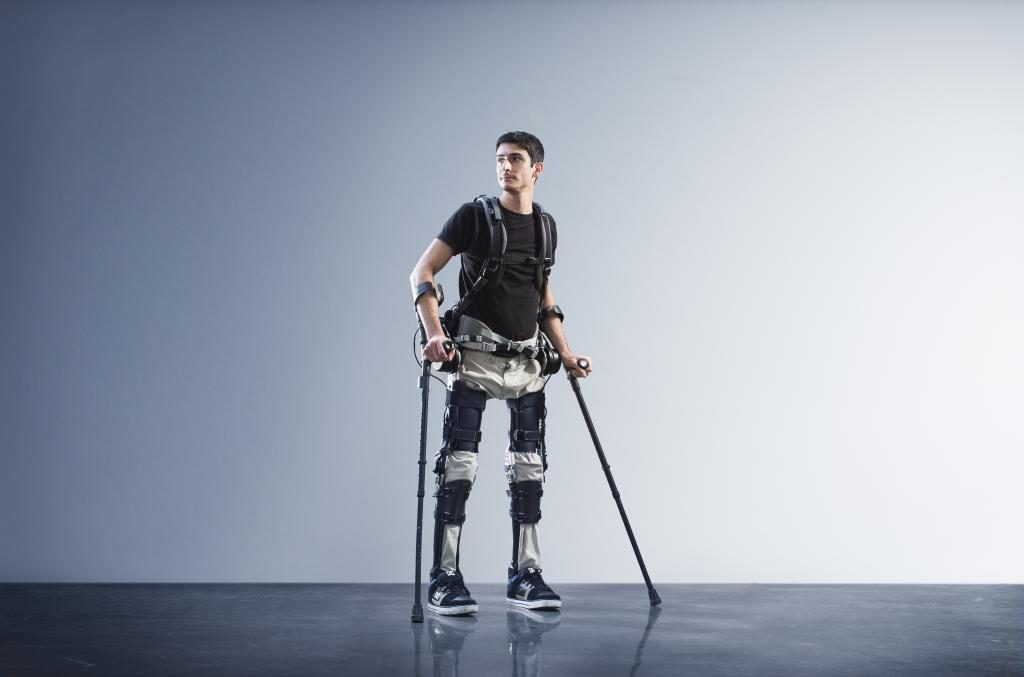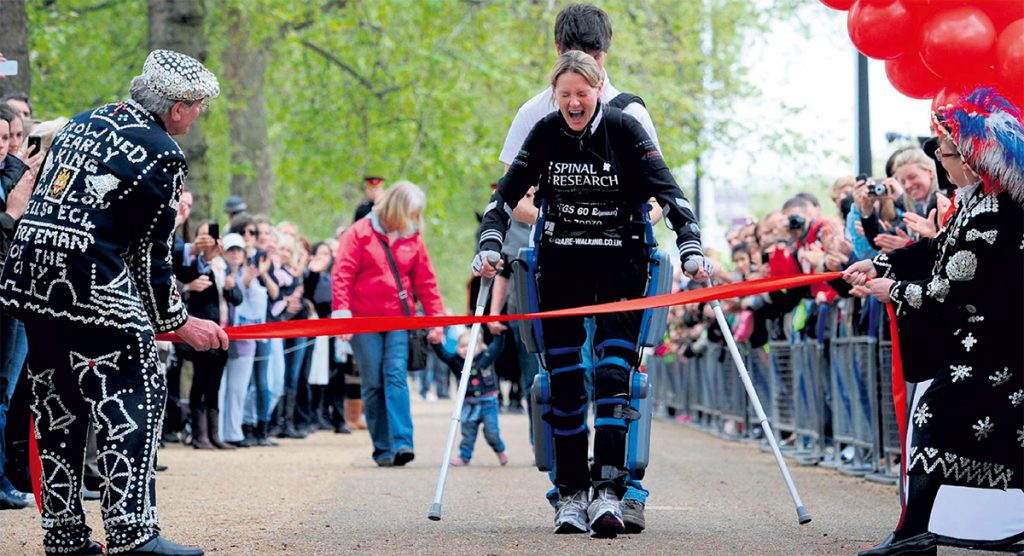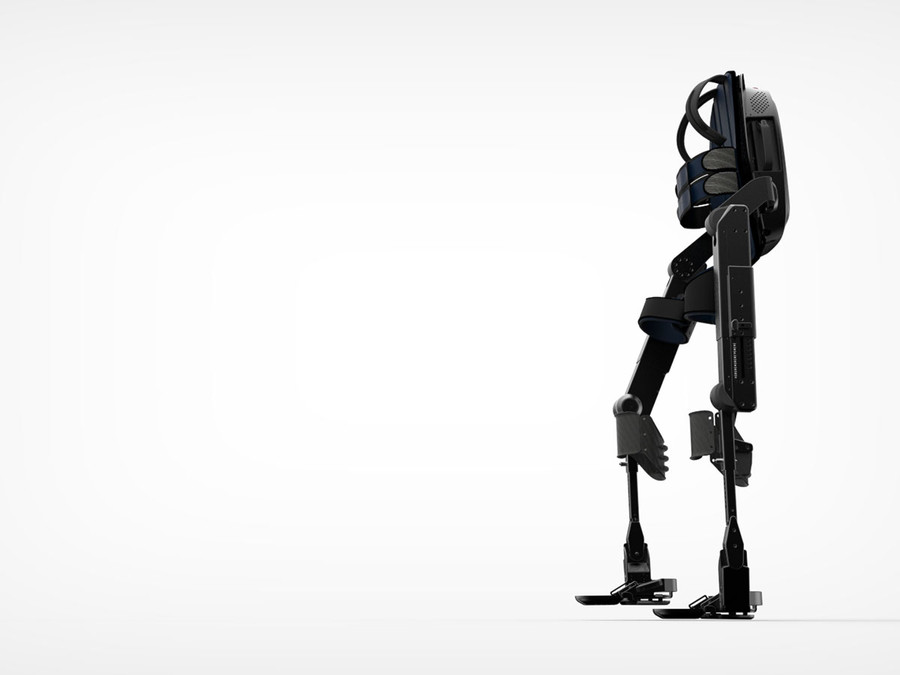New robotic exoskeletons are helping people with disabilities, paralysis and injuries, allowing them to walk again and stave off secondary injuries from prolonged sitting.
Imagine, people with disabilities, after being told they may never walk again, find they can not only walk, but also cover a mile in an hour.
Or, a worker with a physically demanding job who lifts and carries loads of weight every day can wear a suit that does the bulk of the lifting for them. Consider the corresponding change in productivity and morale!
With AI, these scenarios are a reality.
Human Exoskeletons and Where They are Applicable
One robotic exoskeleton, SuitX, has the technology that allows users with lower-body disabilities to cover a mile in an hour. This suit is lightweight, controlled by motors at the hips and knees that move the foot supports. The user wears a backpack battery that will last up to eight hours, and controls the suit with buttons placed on crutches.

A man walks with the help of the Phoenix exoskeleton developed by SuitX. (Source: Instagram)
Another exoskeleton, the ReWalk, is commercially available in the United States. It is strapped onto the user’s body over his or her clothing, again using electric motors for power. Sensors assist in movement, which the user controls through a wrist-worn communicator.

Claire L.uses a ReWalk exoskeleton to complete a race (Source: ReWalk)
Similar technology can be used for exoskeletons in an industrial or military application. Workers and soldiers can wear human exoskeletons to gain an instant boost in strength and stamina, lifting far more than they could heft without the robotic help.
The Application of AI
Alexa, Amazon’s artificial intelligence (AI), is practically a member of the family in many households, especially across the U.S. Alexa stocks up on pantry essentials, shares the latest news, gives weather updates and even plays games. But now, she’s stepping into an all-new role that will truly transform people’s lives, beyond household assistance.
Bionik Laboratories has integrated Alexa to its lower-body exoskeleton. This means that to move, users can simply issue a voice command like, “Alexa, take a step.”

ARKE™ Exoskeleton by Bionik Laboratories (Source: Bionik Laboratories)
Adding AI to exoskeleton controls can potentially help users become familiar with the device. Users may face a steep learning curve with sensors, communicators, and putting it all together to move with an exoskeleton. With the application of AI, however, voice commands get the process started more seamlessly, until users are confident to take over control without Alexa’s help.
While AI-controlled exoskeletons are still in the early stages of testing, the concept holds a lot of promise for enabling greater independence for people who need mobility assistance.
Comparing Exoskeleton Materials
While exoskeletons might seem futuristic, it does not mean that they are made from futuristic alloys and newly invented materials.
Manufacturers are looking for several things from an exoskeleton material: strength, durability and cost effectiveness. Whether AI-assisted or not, exoskeletons are made from a variety of traditionally used materials; typically, carbon, aluminum, or steel.
Some manufacturers may choose carbon for lightweight parts, as this material is not as hefty as steel or aluminum. Steel is the heaviest of all of those materials, but with a powered exoskeleton, the weight may not matter as much, as the machine will be lifting itself.
Aluminum is durable, but not as resistant to damage as steel. Being an inexpensive material, aluminum might seem attractive to manufacturers at first, but that lower price tag comes with a diminished lifetime in comparison to steel.
Carbon is about as damage-resistant as aluminum, but holds less stiffness against weight. Carbon is also generally brittle, so if it faces damage, it may crack and completely break, rather than denting (or being unaffected). High-end carbon can be expensive, potentially driving up the cost of an exoskeleton made with this material.

Different types of exoskeletons (Source: Wired)
Steel, therefore, is very popular for creating exoskeletons and their parts. It provides raw strength and durability. It stands up to many kinds of damage with ease. It bends or dents instead of breaking, and can typically be repaired, even numerous times, without reaching the full point of failure.
Steel lasts, despite wear and tear. This robust material is ideal for limb elements like arms and legs, which will be doing a lot of moving and lifting. Steel will enable extremely heavy lifting of objects many times the weight that an unpowered human could lift.
Like exoskeleton technology, steel technology is evolving. Lighter weight steel materials are coming onto the market, offering all of the benefits that steel has traditionally offered, with less heft.
Whether manufacturers choose steel for every part of an exoskeleton, or select this high-quality material for some important elements of the technology, it is clear that steel has a role in exoskeletons, now and in the future.
Cover photo courtesy of New Atlas.
